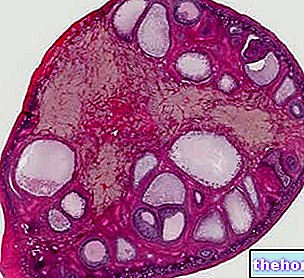Watch the video
- Watch the video on youtube
Definition
Today, the term premenstrual syndrome (PMS = Pre Mestrual Syndrome) indicates a rather complex and heterogeneous set of biological and psychological alterations that are extremely variable from one case to another, but always with a very precise temporal localization with respect to the cycle. menstrual.

It is also important to evaluate the nature of the symptoms, their severity, and the type of basic symptoms, already present in the follicular phase, on which the PMS overlaps.
How widespread is it?
Approximately 80% of women may complain of more or less unpleasant symptoms in proximity to menstrual flow. Approximately, in 10-40% of women, these disorders will have some repercussions on their work and lifestyle, while only in 5% of women of reproductive age will be able to configure the typical picture of PMS. The most important role in diagnosing PMS is played by the severity of symptoms that occur in the premenstrual phase and by the extent of their remission after menstruation.
Symptoms
For further information: Premenstrual Syndrome Symptoms
The symptoms, which usually appear 7 to 10 days before the start of the flow, are extremely variable and difficult to assess in their extent; they range from depression to breast tenderness, from headache to abdominal swelling, from edema (swelling) of the extremities (legs and less frequently arms) to the instability of behavior. In some patients they progressively worsen while in others they reach peaks of considerable intensity interspersed with periods of well-being.
PMS can occur at any time in a woman's reproductive life; it most commonly appears in later years, and in those patients who report a history of long periods of natural menstrual cycles, ie without the use of oral contraceptives. Mostly it does not manifest acutely, but the symptoms undergo a progressive worsening over the years.
Complications
PMS can have social and marital repercussions. In fact, in the most serious cases, there may be poor work performance up to absenteeism, alterations in sexual desire, social isolation. Exceptionally, women affected by this syndrome are responsible for psychotic behaviors (suicide, etc.) or, even, Precisely for this eventuality, PMS is recognized by the legislation of some countries (England, France) as a mitigating condition.
Is it serious?
Usually the syndrome does not go away on its own but by changing one's lifestyle or using some form of therapy.
There are no data on the behavior of the syndrome at the time of the transition to menopause, but it seems that the approaching end of menstruation can positively influence it. There is no evidence that PMS begins or worsens after pregnancy, nor that it its frequency increases after tubal ligation. Little information exists about the influence of heredity on the syndrome, although some data seem to prove the existence of genetic factors.
Causes
Although numerous hypotheses have been advanced, the factors involved in the origin of the various disorders related to premenstrual syndrome are not known with certainty. Among the various theories proposed, they have received the greatest consensus:
- That hormonal, consisting in an altered estrogen-progesterone ratio due to a progesterone deficiency in the luteal phase (the second half of the cycle);
- That of a altered hydro-saline turnover (water-salts) determined by the excess or defect of various hormones that have an action on the hydroelectrolytic balance: estrogen and progesterone, antidiuretic hormone (ADH or vasopressin), prolactin, aldosterone;
- That of thyroid dysfunction, based on the observation that some women with PMS have evident or subclinical signs of hypothyroidism and that in these patients the administration of thyroid hormones results in an improvement of PMS;
- That of vitamin B6 deficiency, based on the relationships between the levels of this vitamin and some endocrine functions;
- That of "hypoglycemia, based on the similarities between the classic picture of PMS and that of the hypoglycemic condition, and on the demonstration that sex hormones are able to influence glucose metabolism;
- The one of prostaglandin E1 deficiency, which are substances involved in the perception of pain;
- That psychosomatic, which is based on psychological, behavioral and social considerations, and on the finding of an association, even if not frequent, of the premenstrual syndrome with real psychiatric pathologies.
However, it is important to bear in mind that up to now it has not been possible to demonstrate differences in the circulating levels of various hormones (including estrogen, progesterone, testosterone, FSH, LH, prolactin) during the menstrual cycle between women with PMS and those without; the same applies to substances involved in the regulation of hydroelectric metabolism such as aldosterone. No differences were recorded even with respect to weight gain.
More recently, theories have been advanced that are based on the fact that sex hormones produced by the ovaries modulate the response to stress. Therefore, it is thought that, in the onset of PMS, during the luteal phase, there is a reduction in concentrations of endogenous opioids, that is, those hormones of "well-being" that are normally produced by the body (endorphins for example, or serotonin), and that this causes an increase in psychological stress.
Other articles on "Premenstrual Syndrome"
- Premenstrual Syndrome: Cures
- Premenstrual Syndrome - Useful drugs against Premenstrual Syndrome
- Nutrition and premenstrual syndrome
- Diet and premenstrual syndrome
- Premenstrual Syndrome - Herbal Medicine























-nelle-carni-di-maiale.jpg)




